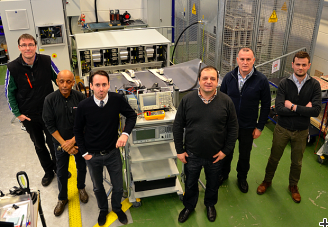Related News
Copyright 2012 neutronsources.org | All rights reserved. | Powered by FRM II | Imprint / Privacy Policy
How Do You Power the World’s Most Powerful Linac?
The Modulator. Carlos Martins and his ESS power converters team, with the help of Lund University researchers, have successfully brought a new high-voltage modulator design to series production. The cost savings and reduced footprint for these large machines mean a paradigm shift for linac power supply worldwide.
Date: 27/03/2017
Source: europeanspallationsource.se
LUND—How do you power the world’s most powerful linear accelerator (linac)? This was the question facing Carlos Martins when he was recruited from CERN to the European Spallation Source (ESS) seven years ago. Last year he and his team delivered their answer: a prototype of the Stacked Multi-Level (SML) Modulator for ESS. This innovation has reduced projected costs by 70% and the vast space requirements for these high-voltage power packs by 80%, relative to the baseline established in 2010.
“We have here in Lund a very interesting development that will be crucial for the project, which is the modulator,” explained ESS Technical Director Roland Garoby in a recent interview. “The modulator is a known difficult piece of equipment in our kind of machines—not especially due to the individual components or the technology in itself—but because it’s electro-technics. It relies on a technology that’s supposed to be established, but the raw power that is involved, the peak power, the voltage, the amps—all energy units—are huge. The stress on the equipment that we have to cycle at the rate of 14 Hz, delivering 11.5 MW of electrical power at this rate is tremendous. So really this is a big challenge and I’m glad that we are completely in control because other facilities have big issues with this.”
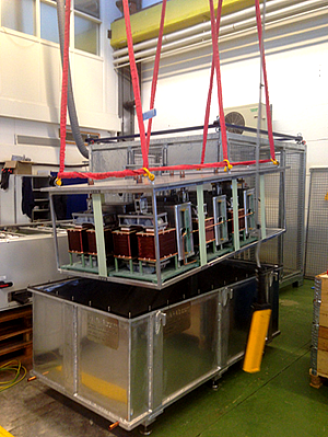
Most Accelerators…
Most accelerators are powered by a standard chain of components. First, you plug it in. AC power from the grid feeds a specialised, but mostly standard, power converter: the modulator. This set of power electronic devices and control software, usually housed in a metal cabinet about the size of a compact car, regulates the power supply to the klystron. The klystron in turn converts about half of this power into electromagnetic waves, or Radio Frequency (RF) power. The RF power is fed to both the room temperature and super-cooled vacuum cavities through which the accelerator’s proton beam is traveling. The RF waves are converted to finely tuned electromagnetic fields inside the horizontally-oriented series of many dozens of these metal cavities, accelerating the beam to ever faster speeds.
These technologies have been around for decades, powering accelerators across the globe. The ESS Accelerator, however, is a game-changer. Its 5 MW power specification makes it five times more powerful than the Spallation Neutron Source in the US, which is the most recently constructed large-scale spallation source in the world. It was suspected by ESS early on that traditional modulator technology would be brought to its limits. Testing would be necessary, and ESS and CERN began to work together back in 2010 to determine if the possible was indeed optimal.
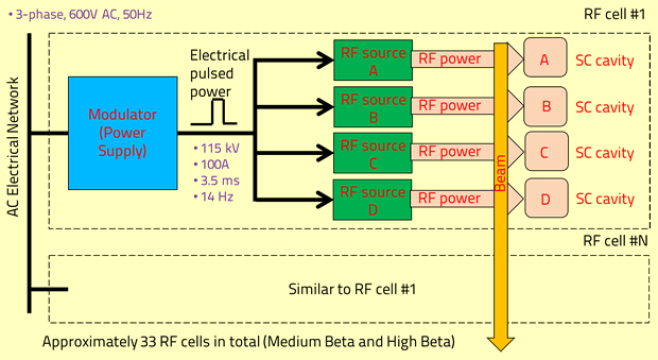
A Procurement Exercise Becomes an R&D Project
In theory, problems of scale for electrical power can be solved simply by scaling up—more modulators produce more power; bigger modulators, bigger power. So ESS, in collaboration with CERN, conducted a market survey in 2011 that led to the purchase of a first off-the-shelf modulator prototype. It was installed and certified in a test stand at CERN in 2014 to determine how far ESS would need to extend current technology. It was then the hard questions began to emerge.
Two things that are not theoretical at ESS are budget and space, and it became clear to the group that scaling up was not the solution to the problem. In fact, given how much of the ESS Accelerator is superconducting, it likewise became clear that scaling down the size and cost of the devices that would power its 146 superconducting cavities would be required. What began as an exercise in defining specifications for a difficult procurement, suddenly became an R&D project.
The decision was made to follow two parallel paths forward: to initiate the procurement of a new modulator able to power two klystrons and likewise meet the demanding specifications required by ESS, work taken up by a Swiss supplier in 2014; and to pursue an internal R&D project, in collaboration with Lund University’s Engineering Faculty (LTH), that would explore non-standard modulator types, or topologies, that might offer an unexpected solution to the problem.
Critical Work Moves to Lund University
“It was mostly ‘D’,” laughs Martins, referring to the extensive hands-on work he and his team took on to build the prototype in time for it to be considered a viable solution. “This was one of the reasons we decided to build the test stand at Lund University (LU).”
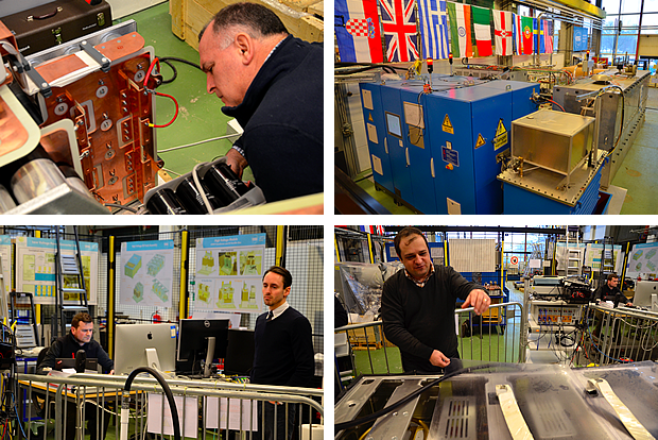
Attempts to outsource the production of the prototype abroad led to numerous complications that led Martins and his team to make the difficult decision to bring the entire production back to Lund. The clock was running out on the SML Modulator concept. Martins describes it this way:
“Three of us—me, [and ESS engineers] Göran Göransson and Marko Kalafatic—went to the production facility of AQ Elautomatik in Lund, and with two of their technicians we built the entire high-voltage tank assembly. We had lost six to eight months with a previous company that was supposed to make the entire design and construction of this complex unit. It was very critical—if we didn’t have an answer in a couple of months this project would be cancelled. We worked every day for one month and one week as technicians at this company. We could see already the second modulator procurement was not going so well, so we thought either this works or we don’t know what we will do. It was really very stressful because we didn’t have a Plan B that would not significantly impact cost.”
Mats Alaküla, Professor in Industrial Electrical Engineering and Automation at Lund University, served as the LU liaison for the project, which involved a handful of researchers from LTH.
“Carlos and his team developed the modulator within my group at Lund University, and I have thus had the privilege to follow it at a close distance,” said Alaküla, who is also a senior scientific advisor for Volvo Global Trucks Technology. “The work they have done is nothing short of a masterpiece of power electronic engineering, and they set an extremely good example for other researchers.”
The Long Pulse Heartbeat of ESS
To fully understand the challenge of the ESS modulator—this unwieldy, seven-tonne welded steel box of capacitors, transistors, magnets, heat exchangers, and wiring, most of which is insulated by a two-tonne bath of biodegradable oil—one has to follow the energy chain all the way to the micrometre-sized samples set delicately in their sample environments on the ESS instruments.
One of the unique characteristics of ESS is that neutrons are not delivered continuously to an experiment but rather in discreet sets of 2.86-millisecond “long pulses”. The instruments at ESS are designed to take advantage of this timing, and the reliability of the beam’s characteristics is critical to the innovative time-resolved experiments that will be performed at ESS.
The delivery of this long pulse relies on the power supply. The proton beam, the RF power, the resonating cavities, the rotating target wheel, the neutron beams and the pulse-shaping choppers for instruments are all synchronised relative to the 14-shots-per-second repetition rate of the beam pulse—14 Hz will be the heart rate for the entire facility. A clean, consistent, and reliable burst of electrical power must be supplied by the modulator at precisely this rate.
10 Million 40-Watt Light Bulbs and A Very Fast 3-Year-Old
The modulator does not continuously dump out the required wattage to keep the Accelerator functioning, it must do so for exactly the right period of time, about 3.5 milliseconds. To do this, it must start and stop the power feed as sharply as possible, with 69 milliseconds to recharge before the next surge. The purity of that flat-topped voltage curve will define the purity of the ESS proton beam. A bad curve can mean unwanted radiation—loose particles—along the accelerator chain. The ESS SML Modulator has achieved a very clean curve: less than 1% voltage droop, less than .17% flat-top ripple, and about 120µs rise time.

“But this is not the only difficult part,” says Martins with a smile. “We want a constant power from the grid. It is like we are flipping this light switch on and off 14 times a second. But this is not a light bulb. This is like 115,000 100-watt bulbs for each modulator. We have 33 of them, 380 megawatts.”
The modulator must serve the needs of the public power grid on the input end: it cannot be siphoning off large amounts of power in massive surges, creating fluctuations in the grid.
“There is no electrical network in the world that would allow us to take 380 MW pulsed power with these characteristics: 3.5 ms, 14 shots per second,” explains Martins. “All the network in Lund, in Sweden, even across Europe would be flickering up and down and that would not be acceptable. So we needed internal filtering somehow in the modulator. We just take from the grid what we need from the average point of view, we don’t want to take any more than that. And we can do this now with 0.3% precision. This is one of the few modulators in the world with internal power regulation to reduce flicker from the local grid, and certainly the first at this power level.”
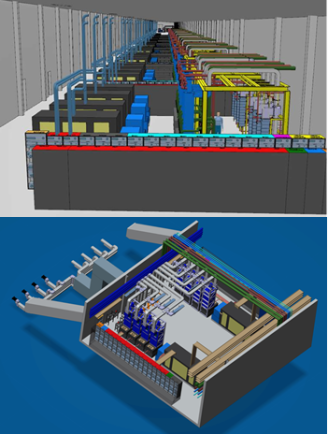
Euros per Square Metre, Power per Square Metre
Modulators are expensive and large. Together, these high-voltage power packs were estimated to be 25% of the cost of the Accelerator project as a whole. In 2010, it was expected that 136 modulators would be required, one for each RF-generating klystron. A visitor to ESS would have seen these beasts lined up as metal cabinets about the size and shape of a Volvo 240—with 1.3 metres of clearance on all sides—running the length of the Gallery Building floor in parallel to the 540-metre Accelerator tunnel.
By the time of the 2013 Technical Design Report, Martins and his team had set a new baseline grounded in the procurement-driven design that would power two klystrons with each modulator. Assuming it could be built to meet the ESS requirements, this new scheme would reduce costs and space requirements by around 30%. That project began in 2014, and was scheduled to be delivered in early 2016. The prototype is still being developed by the Swiss supplier a year later and has already been ruled out as too costly and less reliable than the ESS-designed modulator.
There will now be only 33 modulators—each powering four klystrons—coming in at only a slightly higher unit cost. That is a 70% savings from the configuration assumed in 2010, and 43% savings from the 2013 TDR. And with the size of the new modulator being as compact as a standard one modulator-to-one klystron unit, despite being four times more powerful, the space requirement is reduced by 80% from a typical linac setup.
‘State-of-the-Art In Fact’
Additional cost and space were saved by the ingenious internal power regulation and buffering scheme of the capacitor bank, where constant incoming power is stored and then released in high-voltage bursts in time with the ESS beam pulse. It was estimated in consultations with a well-known power quality firm that without this innovation, self-contained in each modulator unit, two 300-square-metre outdoor, fenced, high-voltage yards would be required to manage the power flicker on the grid, at a total cost of €12 million. This is in fact the existing setup at certain accelerator-driven facilities.
“It’s not something someone would tell you, ‘Yes, this is state of the art,’ but in practice because you push standard engineering very far, it’s a challenge and it becomes state of the art in fact,” explains Garoby. “The technology for the modulator, which has been invented by Carlos, I think will be useful in other places. I know many labs are looking over our shoulders with the expectation that they will use it in the future.”
Downloads: modulator2017_pdf.pdf2.96 MB PDF



